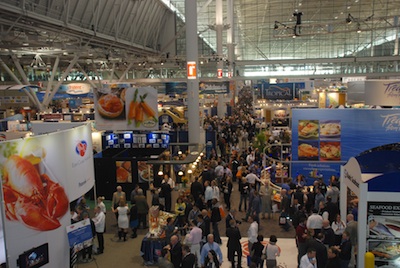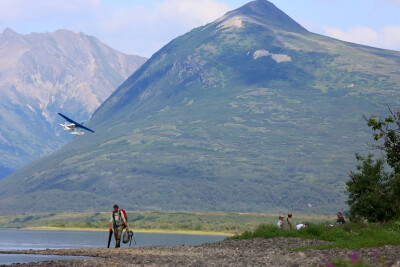If you ever want to take a look at the seafood industry at a global level, come to Boston.
For the last three days I've been at the International Boston Seafood Show, which I cover in my role as assistant editor for SeaFood Business (both NF and SeaFood Business are published by the same company).*
This show is huge. Held at the Boston Convention and Exhibition Center from Sunday through today, the annual event had more than 1,000 exhibiting companies from 46 countries. It was expected to attract more than 19,000 buyers and sellers of seafood.
The U.S. guys are here too — and they're doing business. I saw exhibitors from all coasts displaying their products on the show floor.
U.S. producers were also here to talk about the latest efforts of the National Seafood Marketing Coalition during a luncheon session on Sunday.
Those involved believe that marketing is the only way U.S. seafood will recover market share lost to imports (91 percent of the seafood Americans eat is imported, according to NOAA). The marketing would tout the unique products from the different U.S. regions, raising them above cheaper imports.

The bill to create this didn't gain traction after being introduced last summer by Alaska Sen. Mark Begich. Bruce Schactler, the coalition's executive director and Kodiak fisherman who works with the Alaska Seafood Marketing Institute, said it will be introduced again and soon.
Marketing can also help create markets for under-utilized species. I saw Bruce again on the show floor today. One of his goals for the show is developing a market for herring.

"Most of Alaska herring is used in the Japanese roe market. We're trying to branch off and get Alaska herring into the world food market," said Bruce. "In Europe they eat it for breakfast."
Those efforts using herring in the Global Food Aid Program. Alaska salmon is the only protein that comes out of the U.S. for world hunger aid. From what Bruce was telling me, it sounds like the program has already made some big differences sending canned herring to malnourished people in Liberia.
The show also gives a much different perspective on this industry than that from the docks. I asked Corey Arnold, a Bristol Bay fisherman from Portland, Ore., who was attending the show what he would tell other fishermen about his experience here.
Corey said he was surprised by the number of aquaculture companies here, and the number of breaded fish products. It's a much different world than when you live on the coast and are used to fresh fish.
"The rest of the world is used to eating fish out of a box," he said.
But seafood's global reach can ultimately mean good news for U.S. fishermen who may find a higher price for their quality product in high-end, overseas markets. Speaking at the national marketing coalition session, Harlon Pearce, chairman of the Louisiana Seafood Promotion & Marketing Board, pointed out that soon 50 percent of the world's middle class will be in China.
"We have to be ready to get to those markets," he said.
*Full disclosure: Our parent company, Diversified Business Communications, also produces the Boston show.







